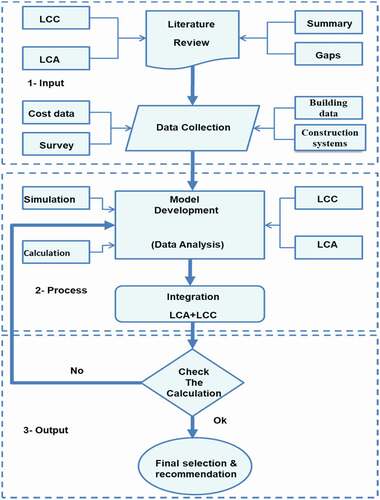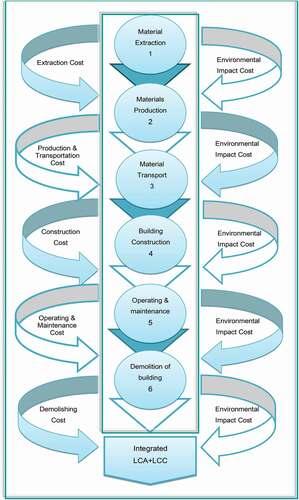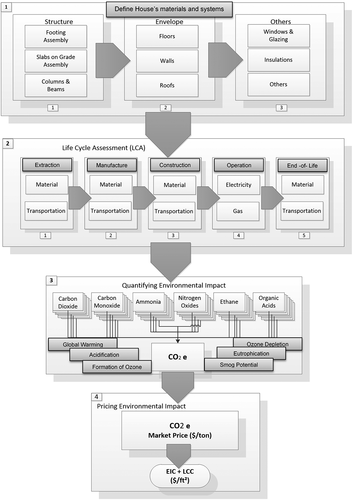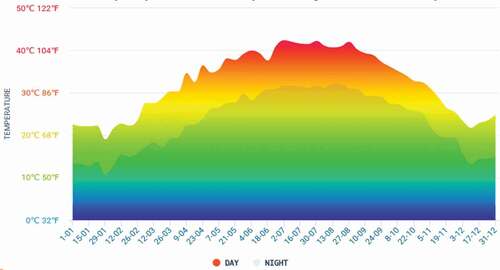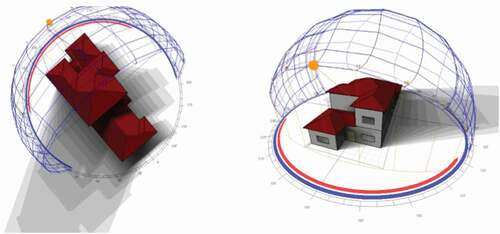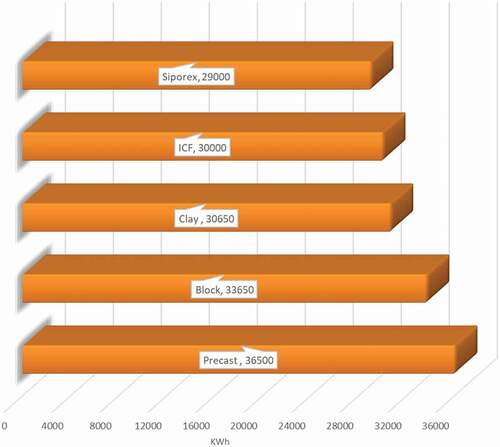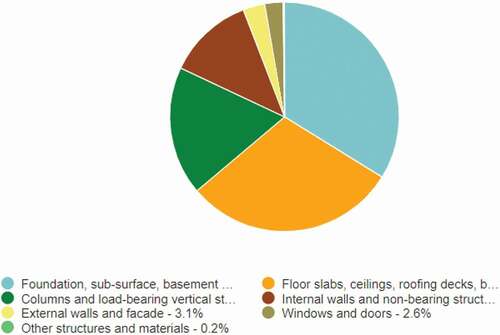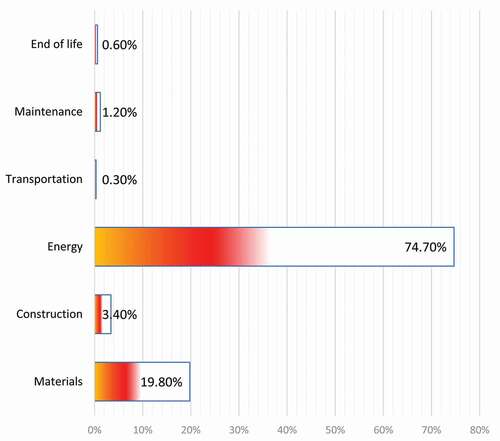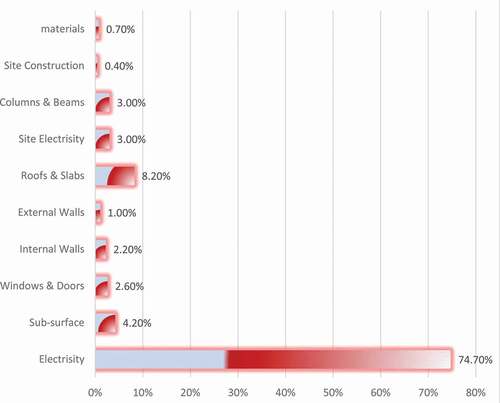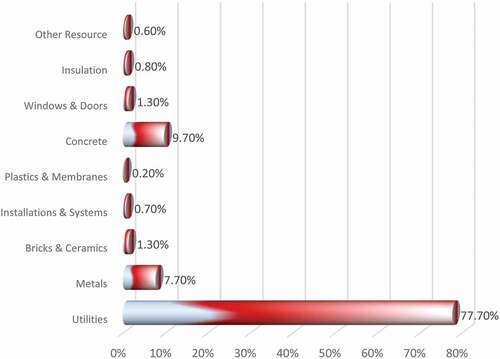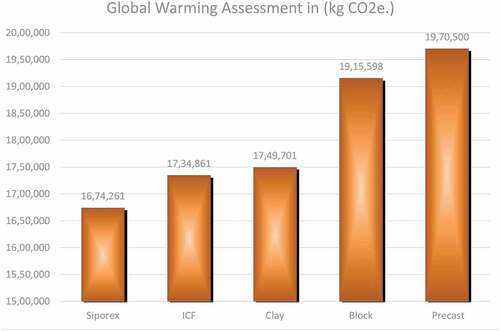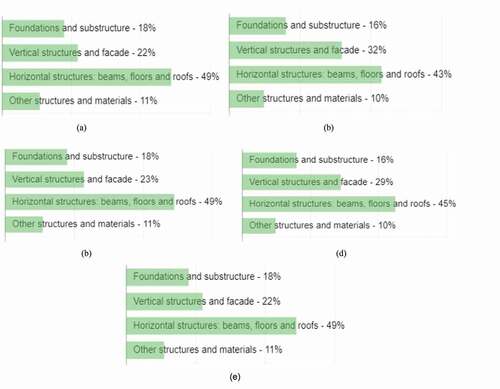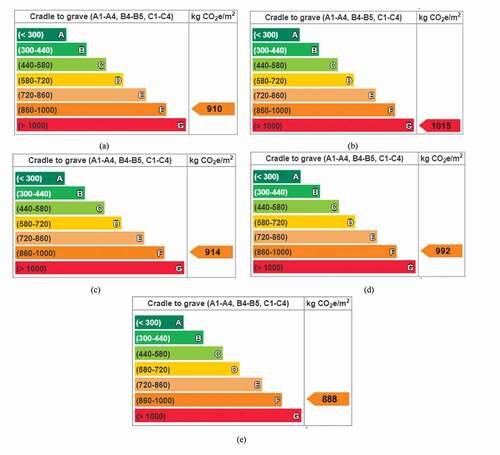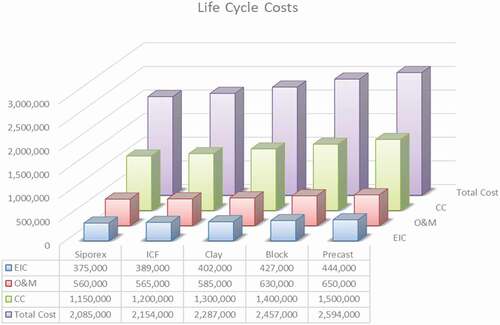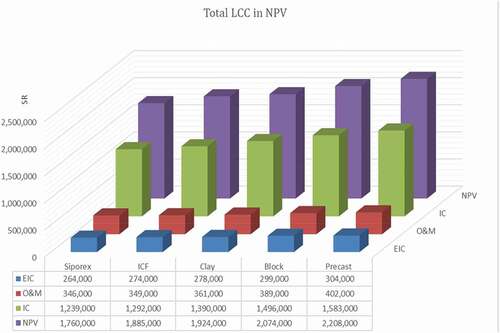 ?Mathematical formulae have been encoded as MathML and are displayed in this HTML version using MathJax in order to improve their display. Uncheck the box to turn MathJax off. This feature requires Javascript. Click on a formula to zoom.
?Mathematical formulae have been encoded as MathML and are displayed in this HTML version using MathJax in order to improve their display. Uncheck the box to turn MathJax off. This feature requires Javascript. Click on a formula to zoom.ABSTRACT
Greenhouse gases associated with energy extraction, production, and consumption are considered a major source of environmental pollution that has led to global warming and climate change. In Saudi Arabia, the building sector represents the largest domain of total energy consumption (roughly 80%) followed by the industrial and agricultural sectors. This study seeks to assess the environmental impacts and economic viability of various construction systems including prefabricated and conventional ones using models for life cycle cost (LCC) and life cycle assessment (LCA). The LCA used in this study was assigned monetary values according to the market price of CO2 and then combined with the LCC. The developed LCA-LCC therefore provides information regarding the sustainability of the construction method and may assist decision makers in public sector on the selection of the best possible construction system to minimize energy consumption, greenhouse gas emission, and environmental impact while simultaneously reducing overall life cycle costs. The highest LCC was associated with construction costs, which represented 55% to 58% of the whole LCC. The operation and maintenance costs of the project over a 50-year lifespan ranged between 25% and 27% of the overall LCC, while the environmental impact cost was found to represent approximately 17.0% to 18% of the total LCC.
1. Introduction
Building construction in Saudi Arabia is becoming the fastest and largest growing market in the Gulf Cooperation Council (GCC) states, offering both lucrative potential to stakeholders and opportunities for achieving and enhancing Vision 2030. According to the national accounts indicators for the third quarter of 2017, issued by the General Organization for Statistics (GOS), construction contributes roughly 7.0% of the Gross Domestic Product (GDP) of Saudi Arabia (). A recent market study in construction showed that there are more than 5,200 construction projects currently ongoing in the kingdom of Saudi Arabia at a value of SR 3.0 trillion (CitationArgaam). The statistics shown in describes the growth rate in construction of residential and non-residential building and infrastructure in Saudi Arabia from 2014 to 2020, with forecasts up to 2023. The expected continuous growth in construction of residential and non-residential buildings is about 7.4% until 2023 (as shown in the chart) (CNBC Citation2018). In relation to investment growth, it is estimated that 2.32 million new homes will be built in the next five years to meet the demands of a growing population, according to the International Monetary Fund (IMF) (Alrashed and Asif Citation2012). According to the National Transformation Program (NTP 2020), the national budget of 2018 showed that the Saudi government is committed to investments for the future with ongoing reforms to diversify away from oil and into construction (Alrashed and Asif Citation2012).
Figure 1. Buildings and infrastructure construction industry growth in Saudi Arabia (CNBC Citation2018).
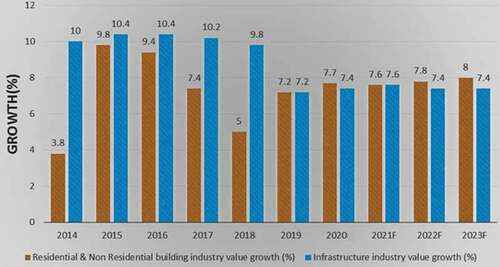
In Saudi Arabia, construction of commercial, residential, and governmental buildings results in excess of electrical energy consumption. The current statistic shows that 3.68 million residential buildings exist in Saudi Arabia with a total resident rate of 21.59 million (CitationArgaam). According to the 2011 Electricity & Cogeneration Regulatory Authority report, construction of buildings makes up about 80% of total energy usage in Saudi Arabia. This figure is followed by energy consumption in industry (18%) and agriculture (2.6%) as presented in . Residential buildings represent the highest energy consumer, reaching about half of sold electricity (49%), followed by industrial buildings (19%), and commercial buildings (16%) (Alaidroos and Krarti Citation2015).
Figure 2. Energy consumption by sectors and type of buildings in Saudi Arabia (Alrashed and Asif Citation2012; Alaidroos and Krarti Citation2015).
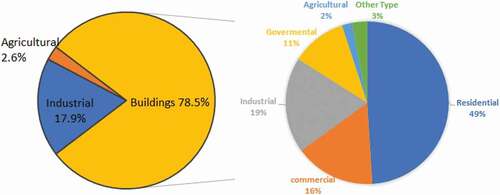
It is assessed that the peak energy demand in Saudi Arabia will upsurge from 55 to 121 gigawatts by 2032 (Alyahya and Irfan Citation2016). Due to the desert climate of Saudi Arabia, electrical energy is mostly consumed for cooling buildings. Additional energy is consumed for heating, use of electrical equipment, and lighting. Environmental emissions associated with energy consumption in buildings reach approximately 5.7 tCo2/Capita; however, Saudi Arabia seeks to reduce its annual emissions by up to 130 MtCO2e by 2030 (Saudi Energy Efficiency Center Citation2018). In order to achieve this goal and to meet the high-energy demand, the Saudi government announced an investment of 200 USD billion to generate 200 gigawatts of energy utilizing Photovoltaic (PV) solar plants by 2030. This should meet the high expected demands by 2035 (IEEFA Citation2018).
The construction of buildings has momentous effects on the environment (Dodman Citation2017). Direct impacts are related to the consumption of materials, energy, and land used for the construction of buildings (Wende et al. Citation2010). Additionally, such consumption releases of greenhouse gases. The indirect impacts of building construction include the energy required to operate and maintain structures over its lifespan, the impacts of building location, and the continued development of the urban landscape (Lall et al. Citation1991; Labonnote et al. Citation2016). As building construction increases, auxiliary environmental impacts may result from additional construction activities such as the development of transportation systems.
Due to the impacts of building construction and urban development on the environment, it is important to minimize energy consumption and promote efforts to create energy-saving structures. The environmental impacts and energy consumption of buildings differ provisionally based on material types and quantities used. The foremost factors that determine the environmental impact of materials are their method of synthesis and the method of their delivery and handling. Other factors that determine material choice include durability and reuse and recycling potential. The use of more environmentally sustainable and energy-efficient materials has been incorporated into building design. Eco-friendly design of buildings has been gaining popularity for their ability to address energy consumption and environmental impact. depicts an example of an eco-friendly house design (Atkinson-Palombo Citation2010).
Figure 3. Eco-friendly home design (Atkinson-Palombo Citation2010).
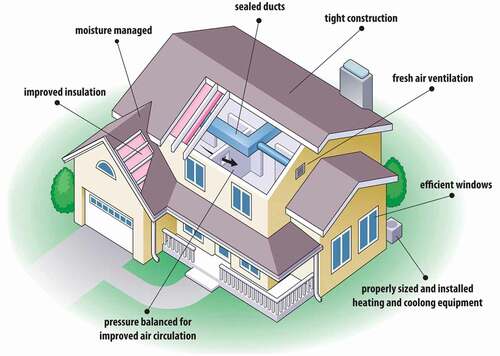
In order to objectively measure the environmental impacts of building construction methods in Saudi Arabia, this research seeks to quantify integrated life cycle costs and develop a life cycle assessment model to measure the sustainability performance level of various construction systems, including modular and offsite construction technologies, and compare them to conventional building construction methods.
2. Background
Numerous types of materials can be used for the construction of energy saving buildings (Pacheco-Torgal and Jalali Citation2011). Given the large array of materials to choose from, professionals typically make their selection based on the need to decrease initial construction costs. Recently, the use of modular construction and offsite-fabricated modules (such as block wall systems and Siporex) have created new alternatives to traditional construction techniques. Modular construction features the use of materials fabricated offsite (such as wall panels, columns, beams, and flooring) that were designed for assembly onsite. Although offsite and modular techniques have more commonly been implemented in low-rise construction (such as residential buildings, warehouses, offices, and single-level commercial or multipurpose buildings), in recent years it has been used in the construction of high-rise and multi-story buildings.
There are limited studies currently published that compare the eco-friendliness of traditional construction methods to newer methods such as modular construction and the use of off-site fabricated modules. For instance, Alshamrani and Alshibani developed a decision support system that helps school boards in selecting the structural and envelope types. This support system includes modular and traditional systems within their new school based on life cycle assessment. The system was developed based on the analysis of 14 different alternatives, including conventional and sustainable ones. The study found that the highest emission for conventional educational facilities is for steel structure systems, while the lowest is for a precast concrete system. It also found that the emission could be cut in half by constructing sustainable systems, compared to the conventional option (Alshamrani and Alshibani Citation2020). The use of life cycle assessment (LCA) to compare these methods may provide more quantitative data on the differences between older and newer techniques for constructing buildings. Life cycle assessment (LCA) is considered to be an efficient tool for measuring the environmental and energy profiles of buildings by calculating energy and material stability over the lifespan of a material in relation to its environment. Construction materials and therefore be compared with results varying based on the building site (Asif, Currie, and Muneer Citation2007). A Life Cycle Assessment (LCA) approach is applied to a study to assess the environmental impact of different modular roof systems of large-span industrial buildings; including steel roof system, precast hollow-core concrete, wood roof systems, and composite roof system. The output of this study showed that steel and wood roof systems have the lowest environmental impact and smallest energy consumption compared to other systems (Alshamrani Citation2021). A study conducted by Zhang & Wang utilized LCA to investigate carbon emissions associated with the construction, maintenance, and operation of buildings over the course of its lifespan. The outputs show that supply-chain emissions and energy play a major role to the overall life-cycle emissions of a building sector. Despite that, the operation stage represents the largest energy consumption and environmental impact in the lifespan of buildings, and the construction stage might cause a significant impact. The emissions and energy consumption during the construction stage make up the highest portion (over 60%) of the life-cycle of the building sector due to the huge number of annual construction projects (Zhang and Wang Citation2016).
The use of LCA to determine the characteristics of building design related to sustainability and energy consumption, prior to the construction of buildings, has more effectively reduced overall environmental impact. For instance, Cofaigh et al. could minimize the environmental impact of a building by 40% by choosing an environmentally favoured building contour and placement; this reduction of impact was found by comparing preliminary designs (“A Green Vitruvius” Citation2012). The ANN prediction model was developed by Hamida et al. for measuring the impact of building envelope types on several environmental-oriented parameters. These parameters included energy consumption, envelope embodied carbon, operational energy carbon and the overall carbon. The ANN model will enable practical implications for the architectural/engineering (A/E) offices by providing a supportive tool to predict the environmental impact of buildings during the early design stage (Hamida et al. Citation2020). A parametric study for building an envelope system’s impact on operational and embodied carbon of residential building is also introduced by Hamida et al. The results of this study indicate that operational carbon represents about 90% of the overall life cycle carbon, whilst embodied carbon accounted for 10%. The sensitivity analysis revealed that the window to wall ratio significantly contributes to an increase in operational carbon by 47.4% (Hamida et al. Citation2021). According to a study by Schlueter and Thesseling, requiring building designers to prioritize eco-friendly parameters resulted in more robust design ideas that both fulfil the needs of clients and results in sustainable architecture (Schlueter and Thesseling Citation2009).
LCA has similarly been applied to approximate the environmental impact of buildings during primary design junctures. For example, in a BIM-based building, the carbon dioxide emission quantity assessment method is proposed by Jun et al. to analyse the decrease in CO2 emission and energy consumption quantitatively and objectively. The findings of this study indicate that the use of the BIM-based CO2 emission assessment method generates a result 20% lower than that of the conventional CO2 assessment method (Jun, Lim, and Kim Citation2015). Pushkar et al. utilized LCA to assemble variables of design into four different clusters and then demonstrated the environmental impact limits of each variable in order to determine overall impact across the lifespan of a building (Pushkar, Becker, and Katz Citation2005). In their study, the environmental impact of public building material and dimensioning substitutes were measured. Sensitivity analysis was accompanied using dissimilar fuel cradles and production methods in order to demonstrate how material quantity affects environmental impact over time. Furthermore, Bribian et al. also applied LCA to premature building designs, analysing communal building component size and materials types, in order to deliver material selection guidelines based on minimizing environmental impacts (Zabalza Bribián, Valero Capilla, and Aranda Usón Citation2011).
Life cycle costing (LCC) is defined as a technique applied to measure the economic costs associated with the construction of a building and the cost of operating and maintaining it over time. It has been used to guide the selection of construction processes by ranking building designs based on cost-effectiveness over the lifespan of a building (Bull Citation2003; Sherif and Kolarik Citation1981). When applying LCC, all costs are calculated to depict present day value, represented as net present value (NPV). To calculate an LCC for the construction of buildings, the following components are needed: construction and material cost (initial costs), operating and maintenance cost (running costs), life cycle assessment cost (environmental impact cost), and salvage value. The LCC approach involves (1) determining objectives for the analysis, (2) setting criteria for evaluating alternatives, (3) identifying the possible alternatives, (4) gathering cost data, and (5) calculating the life cycle cost for all alternatives (Alshamrani Citation2012).
Kirkham developed a software application that uses LCC and includes a decision-support system known as “Logbook”. This software works concurrently with whole life cycle cost (WLCC) models to assist designers in the assessment of various buildings designs. Information regarding building design and construction are recorded in this application chronologically from the initiation of design to final design optimization (Kirkham Citation2005).
Similarly, Fu et al. developed a LCC tool based on an interoperable building information model (Fu, Kaya, and Aouad Citation2007). It was shown that the developed tool could assist users in making appropriate decisions related to building design by evaluating various construction systems by assessing the LCC for all building components and by calculating a total LCC. Additionally, Menconi and Grohmann developed an integrated LCC and thermal simulation model. Their model can be used to determine economic assessments of insulation types to retrofit roofs using information from existing buildings. In their study, several insulation types were analysed in order to test building microclimate responses, sustainability of the upgrades made to insulation, and expedience of the investment (Menconi and Grohmann Citation2014).
In another study, Salvado et al. developed a conceptual framework to investigate the limitations and correlations between LCC and building management (BM) (Salvado, de Almeida, and Vale e Azevedo Citation2018). A multistage method was applied to develop the framework by addressing six predetermined goals. It was shown that building management modalities such as the management of facilities, programs, portfolios, projects, assets, and data are necessarily connected with LCC. These components of BM related to LCC show the significance of incorporating LCC within areas related to building design, creation, and maintenance such architecture, engineering, and construction.
Furthermore, Marzouk et al. developed a framework that integrates optimization and simulation with Building Information Modelling (BIM) (Marzouk, Azab, and Metawie Citation2018). The developed framework implements a LCC stochastic model to select optimum building materials. The Monte-Carlo Simulation technique was applied as a fitness function for the optimization model, while Genetic Algorithms Optimization was applied to select the desirable options of building materials, taking into account sustainability aspects. These aspects were achieved by assessing the highest number of LEED points that can be obtained. In a different study, Kneifel assessed the effects related to reduction of carbon emission, cost-effectiveness of energy efficiency, and life-cycle energy savings on cost. Twelve prototypical buildings taken from different cities across the United States were analysed. Cost databases of the buildings were used to obtain values for overall energy consumption. This information was used to measure the LCC (to provide information related to economic viability) and carbon emissions of each design. The results concluded that some conventional technologies used energy-efficient techniques that could be applied to minimize energy consumption in new commercial buildings by average of 20–40%, depending upon the location and type of building (Kneifel Citation2010).
Additionally, Ristimäki et al., using life cycle design, developed a frame work for the creation of energy systems for new residential development in Finland (Ristimäki et al. Citation2013). This study assessed the effects of various energy systems on carbon emissions, LCC, and life cycle management (LCM). The study compared the use of district heating systems with and without photovoltaic panels and ground source heat pumps with and without photovoltaic panels. The results of this study showed that source heat pumps with photovoltaic panels is the best option for reducing carbon emission; it has the highest initial cost and the lowest estimated LCC.
In a subsequent study, Kim et al. developed a conceptual model relating carbon emissions to life cycle cost (Kim et al. Citation2013). The model includes five subsystems: decision-making support system, LCC, cost-carbon effect, LCCO2, and energy analysis system. This study was conducted on apartment buildings with designs that represent more than 60% of the residential sector in South Korea. This model assists users in planning for sustainable construction. Lastly, Alshamrani developed a framework that incorporated environmental impact cost into LCC analysis (Alshamrani Citation2012). This framework was developed to enable school boards to select of the best structural systems and building materials for school buildings based on sustainability aspects quantified by the LCC.
LCC models and frameworks were developed in various studies across literature by incorporating several methods. These methods include: decision support systems, ranking approach, simulations, Genetic Algorithms Optimization, stochastic approach, and cost–benefit analysis. However, only a studies considered sustainability aspects such carbon emission and the overall LCA in the development of LCC models. Therefore, this study seeks to integrate both LCC and LCA to investigate the economic and environmental impact of different construction methods used for the creation of residential buildings. For this study, the LCA will be analysed and assigned monetary values according to the market price of CO2, this information will then be combined with the LCC.
3. Methodology
3.1. General method
A systematic and multi-phase methods approach was used to develop the integrated LCA-LCC assessment model used for the selection of construction systems in this study. These construction systems were assessed based on overall cost and environmental impacts when used for the creation of residential buildings in the Kingdom of Saudi Arabia. This model takes into account the following information: construction costs, operating and maintenance costs, annual environmental impact costs, and waste costs. In this research, several construction systems, both prefabricated and conventional construction techniques, are investigated. These systems include the use of Siporex, insulated concrete form (ICF), clay block systems, concrete block systems, and precast concrete systems. Each modality is tested, and its performance is measured using criteria to assess for cost and sustainability. The methodology of the research is divided in three main stages including: literature and data collection (input), data analysis, model development and integration (process), and final check and alternative selection (output) as shown in . Previous studies using LCC and LCA were reviewed to identify knowledge gaps in the field. During the data collection stage, cost data (including discount rate, inflation rate, life span, and energy cost data) was collected for each construction system and material type. The next stage included data analysis and model development in order to create a model that integrates life cycle costs and life cycle assessment based on a deterministic approach. A model output check and verification was then performed on the different construction systems. In the final stage, the best construction system was identified based on the developed LCA-LCC model, taking into account both economic and environmental impact. The LCA conducted in this study was assigned monetary values based on the current market price of CO2. This LCA was subsequently combined with the LCC assessment in order to calculate an overall cost of creating a project featuring a particular construction modality as well as the cost of operating such a building over the course of 50 years.
3.2. Integration Method
The methods followed in this study utilized a life cycle analysis approach. shows the detailed process used for model development, and it encompasses the whole life cycle stages of project including material extraction, manufacturing, transportation, construction, operation and maintenance, and demolition or deconstruction. The environmental impact cost (EIC) was created based on greenhouse gas emissions (GHG) and its resulting global warming potential (GWP) as it relates to the construction modality (conventional versus off-site construction). The combined calculated cost was assessed in this study at each life cycle stage, which involves the estimation of indirect and direct cost at each stage along with its associated environmental impact cost. The overall integrated LCA-LCC is then calculated by combining the computed costs at each stage. In order to create this model, several methods and techniques were implemented, including the use of of energy simulations, life cycle assessments, and analysis of the whole LCC. The components of LCC included initial construction costs, initial environmental impact costs (EIC), annual energy costs for operation and its associated impacts, annual maintenance and repair costs and its associated impact, and the impact costs of deconstruction. Initial environmental impact consisted of costs related to material extraction, material production, and construction. The initial construction costs for each construction system was collected from existing construction market data from the eastern region of Saudi Arabia.
A Saudi townhouse in the city of Dammam was selected as a case study and in order to apply the integrated LCA-LCC model. Two floor systems and the roof were analyzed in this study, and the use of cast-in place solid slabs was compared to precast hollow core concrete slabs. Five construction systems for the building were included in this investigation: Siporex, insulated concrete form (ICF), clay block, concrete block, and precast concrete system (base case scenario).
3.3. Model building and construction system alternatives
A typical Saudi townhouse was selected to apply the developed integrated LCC-LCA model. presents a description of the modelled house building (case study) and characteristics of the climate in the location of construction. This information was used to for the energy simulation and life cycle assessment process. shows a 3D model of the building created by Revit software. This model was used to quantify the materials used in construction and to facilitate the energy simulation using ECOTECT. presents the roof and wall systems investigated in this study. The energy simulation for different construction system alternatives is performed in this study by applying some thermal conditions as shown in .
Table 1. General information of the building modelled.
Table 2. Construction system alternatives.
Table 3. Energy simulation data.
The LCA was performed in this study using One Click LCA metrics software. The input of this software depends mainly on the description of the building location, area, height, year of study, and study period (life span). It also requires a defining of construction systems, materials type, material masses and quantities according to the functional unit options in the simulation software as shown in . For example, the One Click LCA gives the user an option of defining the function unit area and thickness of concrete; or, it can be defined as a volume or weight in tons. Furthermore, it requires the input of an annual operating energy. This value was simulated in advance using the ECOTECT software. shows a sample of the inputted materials provided to the LCA software for one of the construction system alternatives.
Table 4. Sample of materials and their quantity used in the modelling of the townhouse.
The costs of environmental impact are calculated in this paper and combined with other costs overall within the whole life cycle stages. shows the life cycle assessment boundaries and environmental impact cost estimating process. This process includes five major phases: the general information of a project, structural elements, construction systems, conducting of the life cycle assessment, calculating the whole environmental impacts, converting the various emissions into a carbon dioxide equivalent (CO2 e), and lastly pricing the CO2 and calculating the environmental impact costs accordingly. The general information of the building is identified in the first phase. This includes information such building type (townhouse), total area (400 m2), and the expected life span (50 years) all assembled. This phase contains the electricity, natural gas, and water consumption quantification.
Secondly, identifying the structural system, construction materials, and finally the interior elements and other systems are included in the next phase. Employing one click LCA software is done in the following phase. Five different construction systems and materials assess the overall life cycle stages: materials extraction, manufacturing, transportation, construction, operation and maintenance, and the end-of-life. Greenhouse gasses are assessed in the prefinal stage and then converted into (CO2 e). The price of environmental impacts is assumed to be 60 USD (SR 225)/ ton of CO2, based on the current carbon price market. Environmental impact costs are computed in this study and added to the life cycle cost elements in order to select the best construction system and material alternative.
3.4. Climate in the city of Dhahran
The city of Dhahran is located in the eastern region of Saudi Arabia. The climate of the city is typically hot and humid in the summer with cold and wet winters. The hot season typically lasts from June to September. Typically, the coolest month is January while the warmest month is August. Information related to average temperature over the year is presented in . Energy simulation was performed for the model by using Revit and ECOTECT software. presents a 3D view of the modeled building using Revit software along with a sun path and orientation diagram.
4. Results
4.1. Energy simulation results
The output of the energy simulation is shown in . This data shows the annual operating energy consumption of various construction systems. Overall, suggests that the offsite precast concrete system with precast hollow-core slab has the greatest annual electricity consumption at 36,500 kWh. The construction system with the lowest recorded energy consumption is the Siporex system with an annual energy consumption of 29,000 kWh. This value is 26% lower than that of the precast concrete panel system. The construction system with the second-lowest electricity consumption is the cast onsite insulated concrete form system which consumes 21.7% less energy than the precast system, having an annual energy consumption of 30,000 kWh
4.2. Life cycle assessment results
LCA was performed in this study using a town-house set in Dharan, Saudi Arabia as a model. One-click LCA software was used to evaluate and assess the environmental impact associated with off-site and on-site construction systems during the building life cycle stages (assuming 50 years of operation). These measures included the Global Warming Potential (GWP), Ozone Depletion Potential (ODP), Photochemical Ozone Creation Potentials (POCP), Eutrophication Potential (EP), Acidification Potential (AP), Total Use of Primary Energy, and Total Assessed Mass of Building Components and Materials.
4.2.1. Total assessed mass of building components and materials
presents the total assessed mass of building components and materials that is estimated at (2279 tons). The greatest assessed mass of building components and materials is recorded at 757 tons for the subsurface and foundation of the buildings, making up 33.3% of total building mass compared to other masses. The second-highest mass was recorded at 690 tons for the mass of floor, ceiling, and roofing slabs that make up 30% of total mass. This is followed by the mass of columns and load bearing structure that make up 18% of total mass (414 tons), followed by the mass of internal walls and nonbearing structure that make up 12% of total mass (276 tons).
4.2.2. Global warming assessment by resources and materials
Global Warming Potential (GWP), was measured in relation to carbon dioxide (CO2) emissions in kilograms. GWP was measured for materials, transportation, construction, maintenance and replacement, energy usage, and end of life deconstruction related to the townhome model as shown in . The largest GWP was recorded for building operation (with an assumed life-span of 50 years). The maintenance and operation of the building accounted for 74.7% of the total GWP. The second-highest emissions were from material production (19.8%), and this was followed by construction (3.4%).
shows GWP emissions in proportion to the individual components of the base case scenario. Compared to other building components, the highest GWP was measured for grid electricity consumption over the course of 50 years of operation (74.7%), compared to other classifications. The second greatest producer of GWP emissions was due to horizontal structures elements (12.6%), followed by substructure elements (4%), and site electricity consumption (3%).
presents GWP emissions proportion as it relates to material resource type. The highest global warming potential by resource type was recorded for utilities over the span of 50 years (77.7%). The second-highest emission was caused by concrete materials (9.7%), followed by metals (7.7%), and subsequently followed by bricks, ceramics, doors and windows (1.3%).
presents GWP emission values in relation to materials type. The highest global warming potential by material types was recorded for steel (38.9% of total emissions) with a total GWP of 126 tons CO2 eq. The second-highest emission was caused by ready-mix concrete (13% with total emissions) with a total GWP of 42 tons CO2 eq, followed by precast concrete panels (10.4% of total emissions) with a total GWP of 34 tons CO2 eq. This is followed by hollow-core slabs emssions (7.6% with total emissions) with a total GWP of 26 tons CO2 eq. Lastly, the lowest GWP emission was recorded for interior doors and ventilation ducts (0.5%, and 0.1% of total emissions, respectively) with a total GWP of 1.6 tons CO2 eq and 0.48 tons CO2 eq, respectively.
Table 5. Global warming potential by material types.
4.2.3. Global warming assessment by alternatives
and present the total GWP emissions from the different construction modalities throughout the life cycle stages. The highest GWP over 50 years related to the operation and maintenance of the building was associated with the precast concrete system with a total GWP of 1.97 million kg CO2 eq. The lowest GWP was generated by the Siporex construction system with a total GWP of 1.67 million kg CO2 eq. This value is 18% lower than that of the precast system which is the base case scenario. The second lowest GWP emission is recorded for insulated concrete form and the lay block system with total GWP of 1.73 million and 1.75 million kg CO2 eq, respectively. These two construction systems can lower the GWP emission by 14% and 12.5%, respectively compared to that of the base case scenario.
Table 6. Global warming assessment of alternatives in kg CO2e.
4.2.4. Greenhouse gases (GHG) measures by alternatives
shows a summary of total GHG emissions for the different types of construction systems. The highest Acidification Potential (AP) emission of 9.86E+03 kg SO2e is generated by the base case scenario while the lowest emission was recorded for the Siporex system at 8.27E+03 kg SO2e. Overall, Siporex can reduce the AP emission by 19% compared to the base case scenario. The greatest Eutrophication Potential (EP) emission is generated by the base case scenario at 1.35E+03 kg PO4e while the smallest emissions is recorded for the Siporex system at 1.15E+03 kg PO4e. Therefore, the Siporex system can reduce EP emissions by 17% compared to the base case scenario. The highest Ozone Depletion Potential (ODP) emission is generated by the base case scenario at 1.05E-01 kg CFC11e while the lowest emission is recorded for the Siporex system at 0.91E-01 kg CFC11e. This shows that the Siporex system can reduce ODP emissions by 16% compared to the base case scenario. The greatest Photochemical Ozone Creation Potentials (POCP) emission was generated by the base case scenario at 5.22E+02 kg Ethenee, while the smallest emission is recorded for the Siporex system at 4.48E+02 kg Ethenee. The Siporex system can reduce POCP emissions by 16.5% compared to the base case scenario. Lastly, the highest Primary Energy consumption was recorded for the base case scenario at 2.37E+07 MJ, while the lowest consumption was recorded for the Siporex system at 2.01E+07 MJ. This shows that the Siporex system can reduce primary energy consumption by 18% compared to the base case scenario.
Table 7. Greenhouse gases (GHG) measures by alternatives in (index).
presents the embodied carbon of the different types of building components. The greatest embodied carbon was found to be from horizontal structure (roofs, beams, and floors) with a proportion range of 43–49%, followed by vertical structures (columns, bearing walls) with a proportion range of 22–32%, façades with a proportion range of 22–32%, and foundation structures and substructures at with a proportion range of 16–18%. The lowest embodied carbon was recorded for other structures and materials which included staircases, insulation, and air condition materials with proportion range of 10–11%.
4.2.5. Embodied carbon benchmark for alternatives
presents the embodied carbon benchmarks of the various construction systems. The embodied carbon measures included the whole associated carbon emission by the materials from cradle to grave which included: extraction, production, transportation, construction, maintenance and demolishing. This assessment excluded the associated carbon emission of operating energy. The selected benchmark for comparison are global residential buildings from the year of 2019. The lowest embodied carbon for the evaluated Saudi townhouse is recorded for offsite construction (precast) at 888 kg CO2e/m2. This may be due to the fact that most of the building components for this scheme are produced in a controlled factory setting. The next lowest embodied carbon was recorded for the Siporex system at 910 kg CO2e/m2, followed by clay system at 914 kg CO2e/m2. The greatest embodied carbon was generated by ICF system at 1015 kg CO2e/m2. This may be explained by the need for extensive construction operations onsite using steel rebars and concrete for this particular scheme. The onsite ICF system is ranked in the red zone (Class-G > 1000) of benchmark while all other systems are ranked in the orange zone (Class-F < 1000) as presented in .
4.3. Life cycle costing results
4.3.1. Life cycle costing component results
The LCC components involved in this study included costs associated with construction, initial environmental impact, annual energy, annual maintenance, annual environmental impact, and environmental impact of demolition in the future, as shown in . The highest construction cost for the Saudi townhouse building was found to be associated with the base case scenario, costing 1.5 million Saudi Riyals (SR). This cost may be due to the fact that offsite precast construction is still limited. The second highest construction cost is recorded for the concrete block system at SR 1.4 million, followed by clay block at SR 1.3 million. The lowest estimated construction cost is associated with the Siporex system at SR 1.15 million. This cost is 30% lower than that of the precast system. The highest estimated annual electricity cost is associated with the precast system at SR 11,000. This may be due to its heavy mass. The lowest annual electricity cost was found to be SR 8,700 for the Siporex system, and this is 26% lower than that of the precast system. In contrast, the lowest estimated annual maintenance cost is associated with the offsite precast system at SR 2,000, while the highest cost is associated with the block construction systems at SR 2,500. This value is 25% lower than that of the block systems.
The environmental impact cost is computed based on the current market price of CO2, which was estimated to be SR 225/ton CO2 when considering the expected changes in its price over the 50 years of the assumed life span of the model building. The greatest initial environmental impact cost was found for the concrete block system at SR 95,700, while the lowest estimated cost was for the precast system at SR 82,400. This value was 16% lower than that of the concrete block system, as presented in . In contrast, the highest annual environmental impact cost was associated with the precast system at SR 7,100, while the lowest estimated cost is associated with the Siporex system at SR 5,600. This value is 27% lower than that of the precast system. The environmental impact cost at the maintenance stage was found to be equal for all of the construction systems. Additionally, no significant difference was found amongst the different systems with respect to the impact cost of the demolition stage.
Table 8. Life cycle cost components of the different construction systems across life cycle stages.
4.3.2. Life cycle costing groups results
and shows computed life cycle costs of the different construction systems, and this cost spans across the construction and operation and maintenance over 50 years. It also shows the total assessed environmental impact costs across all stages of building development as well as the total estimated cost when excluding the time value of money. The highest estimated LCC was found to be associated with construction cost, which represents approximately 55% to 58% of the total LCC over 50 years. The operation and maintenance cost of the project over 50 years was found to range between 25% and 27% of the total LCC, while the environmental impact cost is found to represent approximately 17% to 18% of the overall LCC.
Table 9. Life cycle cost construction systems.
The greatest calculated total operation and maintenance cost was associated with the precast system at SR 650,000, while the lowest estimated cost was associated with Siporex systems at SR 560,000. This value is 16% lower than that of the precast system. The highest assessed total environmental impact cost is for precast system at SR 444,000, while the lowest cost is estimated at SR 375,000 for Siporex system. This value is 18% lower than that of the precast system. The highest estimated total life cycle cost is found to be associated with the precast system at SR 2.59 million, while the lowest estimated cost associated with the Siporex system at SR 2.08 million. This value is 25% lower than that of the precast system, as shown in and .
4.3.3. Overall life cycle costing in Net Present Value (NPV)
The integration of LCA and LCC was conducted and assessed in this study using the mathematical model developed below. The overall LCC was forecasted using the net present value (NPV) approach which considers the time value of money. Some of the parameters are gathered from the Saudi Central Bank (Citation2020), such as discount rate (i = 5%) and inflation rate (j = 3%). Additionally, the life span (n = 50) was assumed to be 50 years.
where:
CC = Construction Cost
IEIC = Initial Environmental Impact cost
EC = Energy Cost
MC = Maintenance Cost
AEIC = Annual Environmental Impact cost
FEIC = Future Environmental Impact cost
n = study period
j = Inflation Rate
i = Discount Rate
and presents the overall LCC in net present value (NPV). The highest total initial cost was found for the precast system at SR 1.58 million, while the lowest value was associated with the Siporex system at SR 1.23 million. This value is 28% lower than the initial cost of the precast system, as shown in . The initial cost of the ICF system was SR 1.290 million, while the clay block system was SR 1.39 million, representing 23% and 14% reductions in the total initial cost, respectively, compared to the base case scenario.
Table 10. Overall life cycle cost of construction systems measured in NPV.
The greatest present value (PV) of total annual operating and maintenance cost (O&M) was found for the precast system at SR 402,000, while the lowest value was associated with the Siporex system at SR SR 346,000. This value is 16% lower than the PV of the O&M for the precast system, as shown in . The PV of the O&M cost for ICF system was SR 349,000, while the same value for the clay block system was SR 361,000, representing 15% and 11% reductions in the PV, respectively. This data is depicted in .
The greatest PV of the total environmental impact cost was associated with the precast system at SR 304,000, while the lowest value was associated with the Siporex system at SR SR 264,000. This value is 15% lower than the PV of O&M cost of the precast system, as shown in . The PV of environmental impact cost for the ICF system was SR 274,000, while the same value for the clay block system was SR 278,000. This represented a 11% and 9% reduction in the PV of EIC, respectively, compared to the base case scenario, as shown in .
The highest overall NPV of the given construction systems was found for the precast system at SR 2.2 million, while the lowest value was associated with the Siporex system at SR 1.76 million. This value is 25% lower than the overall NPV of the precast system, as shown in . The NPV of the ICF system was forecasted to be SR 1.88 million, while the same value in the clay block system was SR 1.92 million, representing 21% and 14% reductions in the overall NPV, respectively.
5. Discussion
This research paper was developed to enrich and extend the conducted literature in the area life cycle costing and life cycle assessment. The construction systems and material alternatives were evaluated in this study based on the economic and environmental aspects. This was done by developing an assessment model that integrated both Life Cycle Costing (LCC) and Life Cycle Assessment (LCA) from an early design stage. The findings show that the highest LCC associated with construction costs ranges from 55% to 58% of the whole LCC. This is followed by operation and maintenance costs at 25% to 27% of the overall LCC. The environmental impact cost was found to represent approximately 17.0% to 18% of the total LCC. In line with the hypothesis, the results indicate the importance of conducting a life cycle assessment is very significant to determine the parameter of the larger environmental impact. For example, the highest environmental impact among the various life cycle stages was found to be from building operations; which represents 75% to 80% of the total impact across all life cycle stages for the various construction systems.
The developed LCA-LCC model in this research provides new insight into the integration of the environmental and economical dimensions by converting the environmental impact into monetary values and adding them to the whole life cycle cost of building. This study generates a powerful tool for building owners in selecting the most suitable construction system and materials that will reduce the environmental impact as well as the overall LCC. The result of this integrated LCA-LCC model indicates that the environmental impact and overall LCC can be reduced by 25% by selecting the best analysed alternative. It should be noted that the results of this study were limited to the evaluated townhouse model set in the city of Dhahran in the Kingdom of Saudi Arabia. It is also limited in terms of the type of data gathered. Additionally, this work featured assumed values (such as the lifespan of a building having only 50 years). This work also limited the construction systems to five, and excluded numerous other offsite and conventional construction modalities. It should also be clarified that this study was limited to measuring economic and environmental impacts on specific construction modalities. Moreover, the focus of this study is on the integration of LCA-LCC assessments and assigning environmental impact a monetary value, and then combining it to give an overall lifecycle cost. The result of this prediction LCC model is subjected to the assumptions like the discount rate, inflation rate, and current market price for construction materials.
5. Conclusions
The building sector in Saudi Arabia lacks an integrated assessment method to assist with decision-making regarding the construction of the most cost-effective and sustainable. In order to reach these construction goals, building design and construction in Saudi Arabia should apply a scientific approach in selection of construction systems and material types. These assessments should start at the initial stages of project design and consider the cradle-to-grave assessment of a building in order to ensure minimal environmental impacts and cost-efficiency. Hence, the contribution of this research study was to develop an assessment model that integrated both Life Cycle Costing (LCC) and Life Cycle Assessment (LCA) from an early design stage in order to inform on environmental impacts and cost during the construction process and throughout a fifty year lifespan of building operation and maintenance. Following a review of current literature, selection of construction systems and materials types based on a cradle-to-grave costing approach has been used in research worldwide. However, in the Kingdom of Saudi Arabia these techniques have not been implemented, hence the need for LCC and LCA research given the unique climate of Saudi Arabia.
Environmental impact cost was assessed in this study and added to the overall LCC in order to select the best construction system for the creation of a townhouse set in Dharan, Saudi Arabia. The highest LCC was associated with construction costs, which represented approximately 55% to 58% of the whole LCC. The operation and maintenance costs of the project over a 50-year lifespan was ranged between 25% and 27% of the overall LCC, while the environmental impact cost was found to represent approximately 17.0% to 18% of the total LCC. The highest global warming potential among the various life cycle stages was found to be from building operations. Furthermore, operating energy was found to represent a range of 75% to 80% of the total GWP across all life cycle stages for the various construction systems. The highest estimated total environmental impact cost was found for the precast system at SR 444,000, while the lowest cost of SR 375,000 was found for the Siporex system. The Siporex system had an 18% reduction in total environmental impact cost than the precast system. The highest NPV was found for the precast system at SR 2.2 million, while the lowest value was associated with the Siporex system at SR 1.76 million. The Siporex system had a 25% reduction in NPV compared to the precast system. To summarize, the offsite construction system (precast system) has the highest initial construction cost for the townhouse project model in Saudi Arabia compared to other systems. Offsite construction systems were found to generate the lowest embodied Carbon emission; however, they have the highest energy consumption and greatest overall environmental impact due to heavy mass. New offsite construction systems are recommended to be developed in Saudi Arabia and should be constructed from lightweight material in order to reduce the impact of heavy mass. These systems should feature competitive initial construction costs in order to encourage their use. Future work should consider applying the LCC-CLA model developed in this study to evaluate the construction of on different type buildings in different locations in Saudi Arabia. Lastly, future work should investigate the impacts of different construction systems using this model.
Disclosure statement
No potential conflict of interest was reported by the author(s).
Additional information
Notes on contributors
Othman Subhi Alshamrani
Othman Subhi Alshamrani is associate professor in the department of Building Engineering in the college of architecture and planning. He is a former Dean of College of Engineering at Imam Abdulrahaman Bin Faisal University. Dr. Alshamrani is a certified arbitrator in the G.C.C Commercial Arbitration Centre, International Academy for Mediation and Arbitration, and High Academy for Arbitration. Dr. Othman earned his PhD in Civil Engineering in the area of Construction Engineering and Management from Concordia university, Canada 2012. He has a Master degree of building science from University of Southern California, Los Angeles, USA 2007. Dr. Alshamrani had a bachelor of Building Engineering form college of architecture and planning King Faisal University on 2002. Dr. Othman has more than 30 published research papers in considerable international journals and peer-reviewed conferences. Dr. Alshamrani has a professional engineer membership from the Saudi Council for Engineers and the Canadian Society of Civil Engineers.
References
- Alaidroos, A., and M. Krarti. 2015. “Optimal Design of Residential Building Envelope Systems in the Kingdom of Saudi Arabia.” Energy and Buildings 86: 104–117. doi:10.1016/j.enbuild.2014.09.083.
- Alrashed, F., and M. Asif. 2012. “Prospects of Renewable Energy to Promote Zero-energy Residential Buildings in the KSA.” Energy Procedia 18: 1096–1105. doi:10.1016/j.egypro.2012.05.124.
- Alshamrani, O. S. 2012. Evaluation of School Buildings Using Sustainability Measures and Life-Cycle Costing Technique. Montréal, Québec: Concordia University.
- Alshamrani, O. S. 2021. “Life Cycle Assessment for Modular Roof Systems of Large-Span Building.” In Proceedings of the 18th International Conference on Computing in Civil and Building Engineering. ICCCBE 2020. Lecture Notes in Civil Engineering, 98 vols., edited by E. Toledo Santos and S. Scheer. Cham: Springer. doi: 10.1007/978-3-030-51295-8_91.
- Alshamrani, O. S., and A. Alshibani. 2020. “Automated Decision Support System for Selecting the Envelope and Structural Systems for Educational Facilities.” Building and Environment 181: 106993. doi:10.1016/j.buildenv.2020.106993.
- Alyahya, S., and M. A. Irfan. 2016. “Role of Saudi Universities in Achieving the Solar Potential 2030 Target.” Energy Policy 91: 325e328. doi:10.1016/j.enpol.2016.01.019.
- Argaam. “Saudi Construction Sector to Grow 6% between 2019–2024: Report.” [ Online]. Accessed 24 April 2021. https://www.argaam.com/en/article/articledetail/id/1327130
- Argaam. “Statistics Authority: 62.1% Of Housing Units Owned in Saudi Arabia by the End of 2019.” [ Online]. Accessed 24 April 2021. https://www.argaam.com/ar/article/articledetail/id/1346521
- Asif, M., J. Currie, and T. Muneer. 2007. “Comparison of Aluminium and Stainless Steel Built-in-storage Solar Water Heater.” Building Services Engineering Research and Technology 28 (4): 337–346. doi:10.1177/0143624407082390.
- Atkinson-Palombo, C. 2010. “New Housing Construction in Phoenix: Evidence of “New Suburbanism”?” Cities 27 (2): 77–86. doi:10.1016/j.cities.2009.10.001.
- Bull, J. 2003. Life Cycle Costing for Construction. 3rd ed. Taylor & Francis.
- “Contracts Projects/ Pages/.” Accessed 10 December 2018.
- CNBC [ Online]. 2018, October 25. Accessed 9 December 2018. https://www.cnbcarabia.com/news/view/46254
- Dodman, D. 2017. “Environment and Urbanization.” In International Encyclopedia of Geography: People, the Earth, Environment and Technology.
- Fu, C., S. Kaya, and M. K. G. Aouad. 2007. “The Development of an IFC-based Lifecycle Costing Prototype Tool for Building Construction and Maintenance: Integrating Lifecycle Costing to nD Modelling.” Construction Innovation. Information, Process, Management 7 (1): 85–98.
- “A Green Vitruvius: Principles and Practice of Sustainable Architectural Design.” 2012. Choice Review [ Online].
- Hamida, A., A. Alsudairi, K. Alshaibani, and O. Alshamrani. 2020. “Environmental Impacts Cost Assessment Model of Residential Building Using an Artificial Neural Network.” Engineering, Construction and Architectural Management ahead-of-print (ahead–of–print). doi:10.1108/ECAM-06-2020-0450.
- Hamida, A., A. Alsudairi, K. Alshaibani, and O. Alshamrani. 2021. “Parametric Study of the Impact of Building Envelope Systems on Embodied and Operational Carbon of Residential Buildings.” International Journal of Building Pathology and Adaptation ahead-of-print (ahead–of–print). doi:10.1108/IJBPA-08-2020-0064.
- IEEFA. 2018. “Sunny Saudi Arabia Plans a $200 Billion Bet on Solar—Institute for Energy Economics & Financial Analysis.” accessed 24 April 2021. http://ieefa.org/sunny-saudi-arabia-plans-a-200-billion-bet-on-solar/
- Jun, H., N. Lim, and M. Kim. 2015. “BIM-based Carbon Dioxide Emission Quantity Assessment Method in Korea.” Journal of Asian Architecture and Building Engineering 14 (3): 569–576. doi:10.3130/jaabe.14.569.
- Kim, S., S. Lee, Y.-J. Na, and J. T. Kim. 2013. “Conceptual Model for LCC-based LCCO2analysis of Apartmentbuildings.” Energy and Buildings 64: 285–291. doi:10.1016/j.enbuild.2013.05.016.
- Kirkham, R. J. 2005. “Re-engineering the Whole Life Cycle Costing Process.” Construction Management and Economics 23 (1): 9–14. January. doi:10.1080/01446190410001678765.
- Kneifel, J. 2010. “Life-cycle Carbon and Cost Analysis of Energy Efficiency Measures in New Commercial Buildings.” Energy and Buildings 42 (3): 333–340. doi:10.1016/j.enbuild.2009.09.011.
- Labonnote, N., A. Rønnquist, B. Manum, and P. Rüther. 2016. “Additive Construction: State-of-the-art, Challenges and Opportunities.” Automation in Construction 72: 347–366. doi:10.1016/j.autcon.2016.08.026.
- Lall, A. B., M. Pandit, N. Kulshreshta, and P. Appasamy. 1991. “Climate and Housing Form - a Case Study of New Delhi.” Energy and Buildings 16 (3–4): 837–849. doi:10.1016/0378-7788(91)90079-I.
- Marzouk, M., S. Azab, and M. Metawie. 2018. “BIM-based Approach for Optimizing Life Cycle Costs of Sustainable Buildings.” Journal of Cleaner Production 188: 217–226. doi:10.1016/j.jclepro.2018.03.280.
- Menconi, M. E., and D. Grohmann. 2014. “Model Integrated of Life-cycle Costing and Dynamic Thermal Simulation (MILD) to Evaluate Roof Insulation Materials for Existing Livestock Buildings.” Energy and Buildings 81: 48–58. doi:10.1016/j.enbuild.2014.06.005.
- Ministry of Finance. [ Online]. https://www.mof.gov.sa/docslibrary/
- Pacheco-Torgal, F., and S. Jalali. 2011. “Nanotechnology: Advantages and Drawbacks in the Field of Construction and Building Materials.” Construction and Building Materials 25 (2): 582–590. doi:10.1016/j.conbuildmat.2010.07.009.
- Pushkar, S., R. Becker, and A. Katz. 2005. “A Methodology for Design of Environmentally Optimal Buildings by Variable Grouping.” Building and Environment 40 (8): 1126–1139. doi:10.1016/j.buildenv.2004.09.004.
- Ristimäki, M., A. Säynäjoki, J. Heinonen, and S. Junnila. 2013. “Combining Life Cycle Costing and Life Cycle Assessment for an analysis of a New Residential District Energy System Design.” Energy 63: 168e179. doi:10.1016/j.energy.2013.10.030.
- Salvado, F., N. M. de Almeida, and A. Vale e Azevedo. 2018. “Toward Improved LCC Informed Decisions in Building Management.” Built Environment Project and Asset Management 8 (2): 114–133. 2017. doi:10.1108/BEPAM-07-2017-0042.
- Saudi Central Bank. “Inflation and Interest Rates.” Accessed 3 December 2020. https://www.sama.gov.sa/en-us/pages/default.aspx
- Saudi Energy Efficiency Center. “Energy Sectors- Buildings.” Accessed 26 December 2018. https://www.seec.gov.sa/en/blog/buildings
- Schlueter, A., and F. Thesseling. 2009. “Building Information Model Based Energy/exergy Performance Assessment in Early Design Stages.” Automation in Construction 18 (2): 153–163. doi:10.1016/j.autcon.2008.07.003.
- Sherif, Y. S., and W. J. Kolarik. 1981. “Life Cycle Costing: Concept and Practice.” OMEGA - the International Journal of Management Science 9 (3): 287–296. January. doi:10.1016/0305-0483(81)90035-9.
- Wende, W., W. Huelsmann, M. Marty, G. Penn-Bressel, and N. Bobylev. 2010. “Climate Protection and Compact Urban Structures in Spatial Planning and Local Construction Plans in Germany.” Land Use Policy 27 (3): 864–868. doi:10.1016/j.landusepol.2009.11.005.
- Zabalza Bribián, I., A. Valero Capilla, and A. Aranda Usón. 2011. “Life Cycle Assessment of Building Materials: Comparative Analysis of Energy and Environmental Impacts and Evaluation of the Eco-efficiency Improvement Potential.” Building and Environment 46 (5): 1133–1140. doi:10.1016/j.buildenv.2010.12.002.
- Zhang, X., and F. Wang. 2016. “Hybrid Input-output Analysis for Life-cycle Energy Consumption and Carbon Emissions of China’s Building Sector.” Building and Environment 104: 188–197. doi:10.1016/j.buildenv.2016.05.018.

